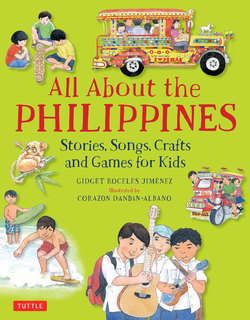Читать книгу All About the Philippines - Gidget Roceles Jimenez - Страница 7
На сайте Литреса книга снята с продажи.
ОглавлениеAncestral Voyages
The Philippines is an archipelago, which is a group of islands that form a single country. It is believed that the Philippines’s first settlers were descended from mainland Asians who migrated to Taiwan thousands of years ago. Over time, their descendants developed strong seafaring abilities, eventually sailing from Taiwan to the Philippines, Indonesia, Borneo and Malaysia. With so much nautical skill spreading out over the region, trade and migration grew quickly. That’s how it all started.
By the 10th century a steady trade route had opened up from India to China. Business boomed. Chinese and Arab traders came to trade exotic new goods and to settle on the islands. They brought new customs, languages and religions to the region.
The Barangay Outrigger
A Barangay was a large wooden outrigger that carried the Malayo-Polynesian peoples to the islands. These boats were big enough to carry extended families of a hundred people! The families settled along coasts and riversides all across the islands. The word Barangay now refers to a small community, like a village or neighborhood.
Chinese Junks
Chinese merchants and traders came in their large Junk boats carrying porcelain vases and plates, silks, artillery, incense and tin. Some stayed to create market places where they could sell or trade their goods.
Arab Dhows
Arab traders came in their smaller Dhow boats, bringing with them linens, wool and metal items. Traveling with them were Muslim missionaries who married local women and spread Islam to the people living in the area.
Ferdinand Magellan
In 1519, Portuguese explorer Ferdinand Magellan traveled east to find the Spice Islands for Spain. Two years later he sailed with his four remaining carracks onto Philippine shores to replenish supplies in the hopes of finishing his journey.
During their short time on the island of Cebu, Magellan and his men converted many of the island’s people to Christianity. But many from the surrounding islands resented these foreign visitors and their Spanish King, Charles I.
Hostility turned into battle, and Magellan and many of his men were killed. Magellan’s ships never reached the Spice Islands, but the accounts of those who made it back to Spain paved the way for conquest and colonization forty years later.
In 1556, the archipelago fell completely under Spanish rule and became known as the Philippines. For 330 years the islands were forced to accept Spain’s king, religion and culture as their own. Today, long after Spanish rule, much of Spain’s influence is still part of everyday Filipino life.
American Warships
On April 25, 1898, the United States attacked the Spanish stronghold in the capital of Manila. Six small warships easily defeated the entire Spanish fleet. With this victory, control over the Philippines passed to the Americans, who went about educating the Filipinos, teaching them English, developing the land and imposing their style of democratic authority.
General Douglas MacArthur
During World War II the Philippines were invaded and occupied by Japan. In 1945, more American warships, under the command of General Douglas MacArthur, brought the conflict to an end. The Philippines became independent in 1946.
